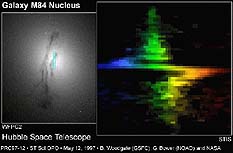
| Bad Astronomy |
|
|
|
BA Blog
|
|
Q & BA
|
|
Bulletin Board
|
| Media |
|
|
|
Bitesize Astronomy
|
|
Bad Astro Store
|
|
Mad Science
|
|
Fun Stuff
|
| Site Info |
|
|
|
Links
|
| RELATED SITES |
| - Universe Today |
| - APOD |
| - The Nine Planets |
| - Mystery Investigators |
| - Slacker Astronomy |
| - Skepticality |
Buy My Stuff

Keep Bad Astronomy close to your heart, and help make me
filthy rich. Hey, it's either this or one of those really
irritating PayPal donation buttons here.
STIS and a Big Black Hole
Week of May 19, 1997

As reported here in last week's snack , new images were released from STIS (the Space Telescope Imaging Spectrograph). One of these images is the zig-zag displayed on the right of the image shown. The center of the elliptical galaxy M84 was observed using STIS to see if there was a giant black hole there (a wide view of the galaxy is seen on the left). Supermassive black holes, millions or even billions of times the mass of the Sun, are believed to be common in galaxy centers. Their huge gravity accelerates matter up to tremendous speeds, but only closer in to the actual black hole. The great resolution of Hubble combined with the spectrographic qualities of STIS allow it to look very close in to the center of the galaxy and look at the matter nearest the black hole.
As the matter spins in faster and faster, the Doppler shift increases. That means that any light emitted by that matter will change its wavelength. STIS can observe different wavelengths of light, like a prism breaks up sunlight into a spectrum. Matter heading towards us shifts to the blue, and matter heading away from us to the red.
The zig-zag you see above shows just that. As the matter spins around the hole, its light gets shifted blue (left) and red (right). Note that the actual colors in the image are not real, but were put in to help people understand what they are seeing-- STIS did not actually see the color as blue and red, like your eye does.
This allows us to measure how massive the black hole is: the bigger the mass, the faster the material moves. The faster it moves, the more the color shifts. So when we calculate the mass of the black hole, we come up with the astonishing mass of 300 million times that of the Sun! Incidentally, STIS was able to get that spectrum using just a 20 minute exposure. Before STIS, it would have taken over thirteen hours! STIS has increased Hubble's capacity to look for supermassive black holes tremendously.
The picture above was taken from the wonderful public Hubble web site. This is a must-see site. There are also a few animations to help understand the images.
I have a couple of black hole pages myself:
This one
has some links to descriptions of black holes, and on another page
I discuss
what would happen if the Sun turned into a black hole.
|
|
| THE PANTRY: ARCHIVE OF BITESIZE SNACKS |
|
|
| Subscribe to the Bad Astronomy Newsletter! |
| Talk about Bad Astronomy on the BA Bulletin Board! |